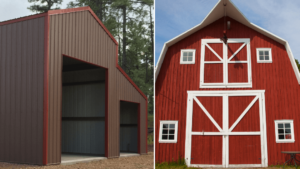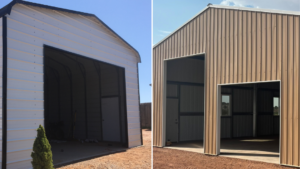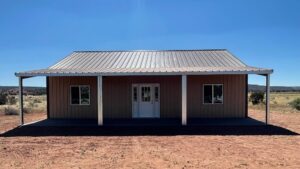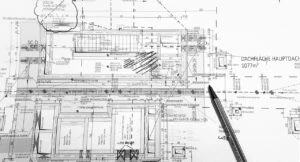Building a new home or investment property is an exciting venture, but it’s also a significant financial commitment. One of the most critical aspects of your project is the foundation—quite literally, it’s what your entire building will stand on. As experienced concrete contractors specializing in metal buildings and construction, we understand the importance of getting your foundation right. But we also know that costs can add up quickly. The good news is that there are ways to save money on your concrete foundation without cutting corners on quality. Let’s dive into some practical tips to help you balance your budget and build a strong, durable foundation.
Understanding How to Save Money on a Concrete Foundation
Factors Affecting Concrete Foundation Costs
Before we talk about how to save money on a concrete foundation, it’s essential to understand what drives the cost of a concrete foundation. Several factors come into play, including the size and design of your foundation, soil conditions, labor costs, and the materials used. For example, if you’re building on a slope or dealing with poor soil, you might need additional site preparation or deeper footings, which can increase costs.
Knowing these factors upfront helps you identify areas where you can potentially save money. For instance, by choosing a simpler foundation design or working with a contractor who knows how to navigate challenging soil conditions efficiently, you can reduce your overall expenses.
Setting a Realistic Budget
Setting a realistic budget for your foundation is crucial. It’s easy to get caught up in the excitement of your new build and overlook some of the costs involved. When creating your budget, include a buffer for unexpected expenses—trust us, there’s almost always something that comes up. Whether it’s an unexpected delay or an additional site prep requirement, having a financial cushion can help you stay on track.
Choose the Right Contractor
Importance of Hiring an Experienced Contractor
One of the most significant decisions you’ll make is choosing the right contractor. An experienced contractor can save you money in the long run by avoiding costly mistakes and knowing how to get the job done right the first time. We’ve seen cases where homeowners tried to save money by hiring the cheapest contractor they could find, only to end up spending more on repairs and corrections later.
Get Multiple Quotes
Don’t be afraid to shop around. Getting quotes from several contractors is a smart move to ensure you’re getting a fair price. But remember, the lowest quote isn’t always the best choice. Look at what’s included in each quote—materials, labor, timelines—and make sure you’re comparing apples to apples.
Consider Contractor Relationships
Another benefit of working with a seasoned contractor is their relationships with suppliers. A contractor with strong ties to suppliers can often get better prices on materials, and those savings can be passed on to you. For instance, we have long-standing relationships with several concrete suppliers, which allows us to secure discounts that we can then offer to our clients.
Optimize Your Foundation Design
Simple Design Adjustments
When it comes to your foundation, simpler is often better—and cheaper. Complex foundation designs with lots of angles and varying depths can drive up costs quickly. By sticking to a more straightforward design, you can keep costs down without sacrificing quality. For example, opting for a basic rectangular or square foundation can save you money on both materials and labor.
Consider a Slab-on-Grade Foundation
For many projects, a slab-on-grade foundation is a cost-effective choice that doesn’t compromise on quality. This type of foundation involves pouring a single layer of concrete, which acts as both the foundation and the floor of the building. It’s especially suitable for warmer climates where frost isn’t a concern. We’ve recommended slab-on-grade foundations to several clients who were looking to save money, and they’ve been pleased with the results.
Reuse and Recycle Materials
Reusing and recycling materials is another way to save money without cutting corners. Ensuring that no unused concrete doesn’t get wasted.
Material Choices and Alternatives
Bulk Purchasing of Concrete
Buying concrete in bulk can lead to significant savings, especially if you’re working on a larger project. When you buy in larger quantities, suppliers are often willing to offer discounts. It’s worth discussing this option with your contractor to see if it’s feasible for your project.
Use of Fly Ash or Slag Cement
Another way to reduce costs is by partially replacing the cement in your concrete mix with fly ash or slag cement. These materials are byproducts of other industrial processes and can be used to replace a portion of the cement in the mix. Not only are they more affordable, but they can also enhance the durability and strength of the concrete. We’ve used these alternatives on several projects, and they’ve performed just as well, if not better, than traditional concrete mixes.
High-Quality, Cost-Effective Reinforcements
When it comes to reinforcing your concrete foundation, there are cost-effective alternatives to traditional steel rebar. For instance, fiber-reinforced concrete incorporates fibers into the mix, which can reduce the need for rebar and lower costs. We’ve found that for certain projects, this approach provides excellent strength while keeping expenses down.
Efficient Project Management
Schedule Work During Off-Peak Seasons
Timing can also impact your costs. Scheduling your project during the off-peak construction season, typically in the fall or winter, can lead to lower labor costs. Contractors may be more available and willing to offer competitive pricing during slower periods. We’ve had clients save significant amounts by simply adjusting their project timeline to take advantage of off-peak pricing.
Avoid Change Orders
Change orders—those little (or big) changes you make during construction—can add up quickly. While it’s tempting to make adjustments as you go, each change usually comes with additional costs. That’s why thorough planning is so important. By finalizing your design and material choices before construction begins, you can avoid costly change orders down the line.
Monitor the Construction Process
Staying involved in your project is key to ensuring quality while controlling costs. Regular site visits and clear communication with your contractor can help you catch potential issues early. We always encourage our clients to be hands-on, as it helps ensure that the project stays on budget and on schedule.
Long-Term Savings Considerations
Energy Efficiency and Insulation
Investing in energy-efficient options for your foundation, such as insulated concrete forms (ICFs), can save you money on utility bills in the long run. ICFs provide excellent insulation, reducing the need for additional heating and cooling. While the initial cost might be slightly higher, the long-term savings can be substantial.
Preventative Measures
Finally, don’t forget about preventative maintenance. Taking steps to protect your foundation from water damage and other issues can prolong its life and help you avoid costly repairs in the future. Simple measures like ensuring proper drainage and sealing any cracks as soon as they appear can make a big difference.
Conclusion
Building a strong, durable concrete foundation doesn’t have to break the bank. By understanding the factors that affect costs, choosing the right contractor, optimizing your design, and making smart material choices, you can save money without compromising on quality. Remember, a little extra effort in planning and decision-making can lead to significant savings and a foundation that will stand the test of time.
If you’re planning a new build or looking for ways to save on your concrete foundation, we’re here to help. With years of experience in metal buildings and construction, we can guide you through the process, ensuring you get the best value for your investment. Reach out today for a consultation, and let’s build something great together!
Follow us on social media!





